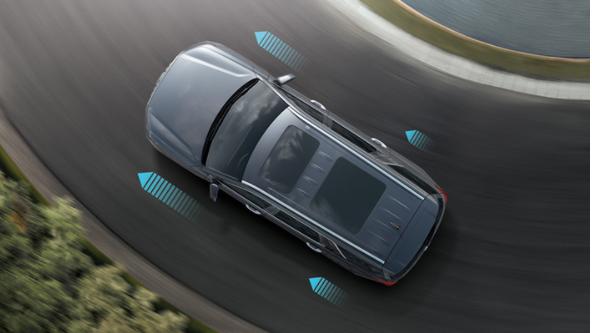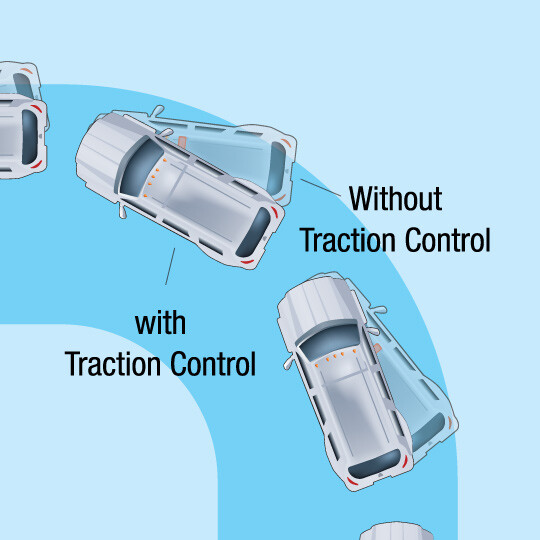Tension Control System (TCS): Car Sustainability Guard in difficult conditions
In today’s charming car, safety systems are constantly evolving to make driving not only more enjoyable, but also safer than ever. Among these advanced technologies, the tensile control system (TCS) as a silent savior plays a vital role in maintaining the balance and sustainability of the car, especially when road conditions change and are challenging. You’ve probably seen scenes that, on rainy or winter days, a car when moving, especially in the screws, has a sudden slip of the wheels and controls the driver. This phenomenon, known as “weeding”, not only disrupts the balance of the car, but can lead to unfortunate traffic accidents.
In the meantime, the Tension Control System (TCS) as a clever and efficient solution has taken the automotive industry. The system, which stands for “Traction Control System”, is designed to maintain stretching and prevent the wheels from turning into slippery and unfavorable road conditions. Currently, fewer modern cars can be found that is devoid of this valuable system. The world’s largest automotive companies, including industry giants such as BMW, Mercedes-Benz, Toyota, KIA and many more, widely use the TCS system in their products and identify it as one of the main components of their car safety.
Vital Importance of Tension Control System (TCS)
The traction control system, using a set of smart components and precision sensors, is capable of improving the stability of the car under different conditions. The performance of this system can be likened to the anti -lock brake system (ABS). Just as the ABS prevents the wheels from locking during severe braking, the TCS also prevents the wheels from traveling when accelerating and moving on slippery surfaces. In fact, ABS and TCS can be considered two twin brothers in the automotive safety system that complement each other and work together to provide maximum safety level. For this reason, today it is almost impossible to get the highest safety scores on world -renowned tests, without taking advantage of these two advanced systems.

TCS, in close cooperation with the ABS system, is capable of carefully controlling the torque applied to the wheels. This torque control not only helps maintain the car’s balance, but also keeps the engine speed in more balanced conditions. In other words, TCS prevents the wastage of the engine and improves the efficiency of the car by preventing the wheels from being unnecessary. One of the obvious disadvantages of older cars, especially powerful cars, was the weaving of driving wheels on slippery surfaces such as ice and snow. Experienced drivers must remember unpleasant memories of grappling with this problem. In the past, even on dry surfaces, cars with powerful engines could have been expanded due to high torque of the engine. Looking at the number of accidents and injuries caused by the lack of proper traction control in modern cars, the critical importance of the TCS system can be found. In fact, TCS and ABS are recognized as two key pillars of maintaining today’s car safety, and any discussion of the benefits and performance of TCS is always raised in terms of the role of ABS supplement.
The evolution of the modern traction control system
Throughout the history of the automotive industry, there has always been continuous efforts to improve the safety and safety of the occupants. In line with these efforts, the problem of wheels and the loss of vehicle control at dangerous levels has also attracted the attention of engineers and designers. To solve this problem, there are various solutions that we will first deal with the preliminary and outdated solutions, and then we will reach the TCS system as the best current solution. The first solution to the implementation was the use of limited slip differentials (LSD). The performance of these differentials was such that if one of the car’s stimulant wheels loses its contact with the ground, it would move the engine torque to the other wheel with adhesion rather than freezing. This solution would some extent preventing the full torque and helping the car continue to move as the wheels were stretched. Although LSD differentials were a forward step, they also had some limitations and failed to completely resolve the problem of wearing.

The Max Trac system was another initial attempt to counter the wheels. Launched in the 1980s, the system uses an elementary computer to improve its performance. Max Track tried to detect and prevent the speed between the front and rear wheels by measuring the speed difference between the front and rear wheels. The system was also significant in its time, but it still lacks the accuracy and efficiency of today’s modern systems. The real turning point was in year 2, when Mercedes -Benz managed to invent a system called ETCS. The system, which has gradually evolved and now known as TCS (traction control system), has made a major change in car safety. The tensile control system (TCS) continues to monitor the rotation speed of each wheel using speed sensors mounted on each car wheel. These sensors send the wheel speed information to the electronic control unit (ECU), and the ECU analyzes this information if they are detected, taking the necessary steps to control the wheels.
As mentioned earlier, the TCS system shows its optimal performance in close cooperation with the ABS system. Many times, roads can provide a combination of rugged, frost and wetness at the same time. In such circumstances, only cars equipped with advanced traction control system will be able to maintain balance and move safely. The ability of these cars to cross the slippery surfaces is directly due to the presence of the TCS system, and in the absence of it, driving in such circumstances will be far more dangerous and difficult.
How the Tension Control System Functions (TCS)
The efficient performance of the traction control system (TCS) depends on the exact speed sensors on each car wheel. These sensors steadily measure the rotation speed of each wheel and send information to the electronic control unit (ECU). When sensors recognize abnormal conditions such as the sudden increase in the rotation speed of a wheel (indicating the web), they send a warning to the ECU. At this moment, the vehicle control unit (ECU) is initially called on the anti -lock brake system (ABS) to help the car cooperate with TCS. ABS brakes are intelligently and selected on the wheels that are overwhelmed. This selective braking procedure reduces the speed of rotation of the wheel and allows it to re -engage with the road surface and obtain the necessary traction. As a result of this process, the main purpose of the tensile control system (TCS) is realized and the vehicle continues without weaving and loss of balance.
Tension Control System (TCS) and Snow: A misconception

The Tension Control System (TCS) is undoubtedly an extremely efficient technology, and drivers who have had the experience of driving cars equipped with the system are well aware of its importance and performance. However, there is a common misconception among some drivers, which is that the traction control system can effectively help move the car in heavy snow. In fact, it should be said that the TCS system is not specifically designed to deal with snow. Although the TCS can also help the driver while slipping on the snow surface and prevent the car from sudden deviation, the TCS alone will not be able to remove the car from the snow. In such circumstances, using wheel chains, helping another car, or draining some of the tires can be helpful.
Never deactivate the tensile control system: Don’t sacrifice safety!
The performance of the traction control system is not limited to rough and slippery surfaces. Sometimes, even on smooth roads, especially at high speeds, it may require the performance of this system. The maximum feeling of the need for TCS occurs when the screws pass, as the screws increase the likelihood of the wheels to rotate due to the sudden change of direction of motion and centrifugal force. The bolts in the screws can lead to the complete loss of vehicle control and the occurrence of adverse events. Fortunately, the tensile control system (TCS) acts as a safety shield as a constant activation and, in collaboration with ABS brakes, prevents potential risks. During the screws, the TCS prevents the wheel from wearing, and helps the driver to direct the car in the right direction. As such, TCS not only makes driving safer in difficult conditions, but also in normal conditions, by increasing the stability and control of the car, it helps to maintain the life of the driver and occupants.
Iran Roads: A solid reason to need TCS
Iran’s winding and mountainous roads, especially roads such as Chalus, need safe and conscious driving. On these roads, sudden climate changes, steep screws and slopes make driving conditions extremely challenging. In such circumstances, the tensile control system (TCS) is more important than ever. A fun driving with modern cars can sometimes tempt drivers to drive at high speeds. While high speed may be enjoyable, it can be very risky on high -risk roads. Given the specific conditions of Iranian roads and the tendency of some drivers to high speed, keeping the TCS lighting (TCS) is an undeniable necessity. The TCS activation assures the driver that if the risk occurs, the system will automatically operate and help him control the car and prevent the accident by providing a few seconds.
Overall tasks of the traction control system (TCS)
The tensile control system (TCS) in modern cars, especially German cars, usually operates with the ABS system. Depending tasks for this system are intended to be performed in all TCS -powered cars around the world. The most important tasks of the traction control system are:
- Prevent the wheels from slipping during acceleration: During a sudden and severe acceleration, the TCS system prevents the wheel from turning and losing the car acceleration.
- Preventing wheels on slippery roads: On slippery surfaces such as ice, snow, rain and oil, the TCS system prevents the wheel from rotating and losing the car balance.
- Helping the vehicle exit from the conditions of getting stuck: If the car wheels are stuck in flowers, ice, sand or sand, the TCS system will help the wheels recovery and remove the car from adverse conditions by applying selective brakes and torque control.
Stretching control system: a depreciable and sensitive part of
The Tension Control System (TCS) is one of the active safety systems of the car, which has numerous sensors embedded on wheels and other components of the system. These sensors may be damaged and damaged on rough and rugged roads due to exposure to harsh environmental conditions and persistent vibrations.
Fortunately, in many cars, the destruction of the sensors or components of the TCS system is accompanied by warning signs such as turning on the TCS alert on the kilometer page or creating abnormal sounds in the cabin. These symptoms warn the driver that the TCS system is in trouble and needs to be reviewed and repaired.
Despite the tremendous performance that the TCS offers, it should be noted that, like other components of the car, it is a portable part of the car and requires periodic maintenance and service. It is recommended that you show your car to an experienced specialist at regular intervals and ensure the health of the TCS system to prevent potential risks for yourself and others. Also, keep in mind that no matter how effective the TCS system is, driving with caution and avoiding risky driving at very rough and dangerous levels will always be the best way to maintain safety and maximize the tensile control system (TCS).
RCO NEWS
















